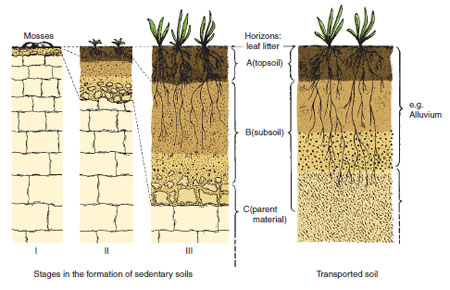Natural soil profiles
ContentSedentary soils Sedentary soils develop in the material gradually weathered from the underlying rock. True sedentary soils are uncommon because most loose rock is eroded, but the same process can be seen where great depths of transported material have formed the parent material, as in the boulder clays left behind after the Ice Ages. A hole dug in such a soil shows the gradual transition from unweathered rock to organicmatter rich topsoil (Figure 17.5). Under cultivation a distinctive topsoil develops in the plough zone.
Once rock fragments and soil particles are created they become subject to erosion. Transported soils are those that form in eroded material that has been carried from sites of weathering, sometimes many hundreds of miles away from where deposition has occurred. They can be recognized by the definite boundary between the eroded material and the underlying rock and its associated rock fragments. Where more than one soil material has been transported to the site, as in many river valleys, several distinct layers can be seen. The right-hand part of Figure 17.5 shows an example. How they are moved depends on where the loose material lies:
Soil development The nature of a new soil (regosols) is largely determined by the rock minerals from which it is formed, but it continues to undergo changes under the influence of climate, vegetation, topography and drainage. These interact over time to give rise to characteristic soil profiles in different parts of the world. The soils that develop can be described in terms of the characteristics of the different horizons (layers) that make up the soil profile. The ‘O’ or ‘L’ horizon is the organic matter found on top of the mineral soil and commonly referred to as the litter layer. The upper layer of the soil, from which components are normally washed downwards, is the ‘A’ horizon. This is usually recognized by its darker colouring, which is a result of the significant levels of humus present. The lighter layer below it, where finer materials tend to accumulate, is the ‘B’ or illuvial horizon. Under cultivation, the ‘A’ horizon broadly aligns with the ‘topsoil’ and the ‘B’ with the ‘subsoil’. The parent material below these is the ‘C’ horizon and where there is an underlying unweathered rock layer it is often known as bedrock. |





